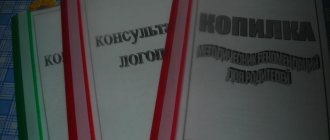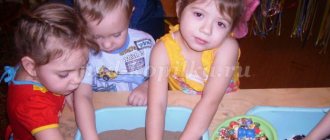Didactic games in the work of a speech therapist teacher
A didactic game is a type of activity in which children learn. Games are aimed at solving specific problems of teaching children, but, at the same time, they manifest the educational and developmental influence of gaming activities.
The need to use didactic games as a means of teaching children at primary school age is determined by a number of reasons:
- gaming activity as a leading one has not lost its importance.
L.S. Vygotsky wrote that “at school age, play does not die, but penetrates into relationships with reality. It has its internal continuation in schooling and in work.” It follows that relying on play activities, play forms and techniques is an important and most adequate way to include children in educational work.
Mastering learning activities and including children in them is slow (many children do not even know what “learning” means).
There are various adaptation difficulties when a child with an intellectual disability enters school (learning a new role - the role of a student, establishing relationships with peers and teachers).
The didactic game greatly helps to overcome these difficulties.
It is impossible to overestimate the role of didactic games in the development of children's speech. Didactic games help develop a sense of the native language and the ability to pronounce words correctly, easily learn grammatical norms, the vocabulary is replenished and activated, and coherent speech develops.
The use of games in speech therapy classes has a positive effect on the quality of correction and training , as it contributes to:
— production and automation of sounds during the game;
— mastery of sound-letter analysis and syllabic composition of words;
- development of lexical and grammatical means of speech within certain topics;
- development of sensory ideas;
— development and improvement of higher mental functions (memory, attention, thinking);
— training of fine differentiated movements of the fingers and hands (has a stimulating effect on the development of speech motor areas of the cerebral cortex, which in turn stimulates the development of speech);
The game also helps create an emotional mood, evokes a positive attitude towards the activity being performed, improves overall performance, and makes it possible to repeat the same material many times without monotony and boredom.
In my work, I often use a variety of didactic games, and I try to include them, if possible, in every speech therapy session.
How to write a term paper on speech therapy
07.09.2010 230132
These guidelines are compiled to help students gain an understanding of the content and structure of coursework in speech therapy.
Logopedia of pedagogical science that studies anomalies of speech development with normal hearing, explores the manifestations, nature and mechanisms of speech disorders, develops the scientific basis for overcoming and preventing them means of special training and education.
The subject of speech therapy as a science is speech disorders and the process of training and education of persons with speech disorders.
The object of study is a person suffering from a speech disorder.
The main task of speech therapy as a science is the study, prevention and elimination of various types of speech disorders.
Coursework in speech therapy is a student's scientific and experimental research. This type of educational activity, provided for by the educational and professional program and curriculum, contributes to the acquisition of skills in working with literature, analyzing and summarizing literary sources in order to determine the range of insufficiently studied problems, determining the content and methods of experimental research, processing skills and qualitative analysis of the results obtained. The need to complete coursework in speech therapy is due to the updating of knowledge concerning the content, organization, principles, methods and techniques of speech therapy work.
As a rule, during their studies, students must write two term papers - theoretical and practical.
The first course work should be devoted to the analysis and synthesis of general and specialized literature on the chosen topic. Based on this analysis, it is necessary to justify and develop a method of ascertaining (diagnostic) experiment.
In the second course work, it is necessary to provide an analysis of the results obtained during the ascertaining experiment, as well as determine the directions and content of speech therapy work, and select adequate methods and techniques of correction.
So, let’s present the general requirements for the content and design of coursework in speech therapy.
The initial and most important stage of working on a course project is the choice of a topic, which is either proposed by the supervisor or chosen by the student independently from a list of topics that are consistent with the areas of scientific research of the department.
Each topic can be modified, considered in different aspects, but taking into account a theoretical and practical approach. Having chosen a topic, the student needs to think through in detail its specific content, areas of work, practical material, etc., which should be reflected both in the formulation of the topic and in the further construction of the study. It should be recalled that the chosen topic may not only have a purely theoretical orientation, for example: “Dysarthria. Characteristics of the defect”, “Classification of dysgraphia”, but also take into account the practical significance of the problem under consideration, for example: “Speech therapy work on speech correction for dysarthria”. It should also be taken into account that when formulating a topic, excessive detail should be avoided, for example: “Formation of prosodic components of speech in preschoolers of the sixth year of life attending a preschool institution for children with severe speech impairments.”
The course work includes such mandatory parts as: introduction, three chapters, conclusion, bibliography and appendix.
The text of the term paper begins with the title page . An example of its design can be seen here.
Then the content of the work is given, in which the names of chapters, paragraphs, and sections are formulated in strict accordance with the content of the thesis. An example of its design can be seen here.
In the text, each subsequent chapter and paragraph begins on a new page. At the end of each chapter, the materials are summarized and conclusions are formulated.
The introduction reveals the relevance of the problem under consideration in general and the topic being studied in particular; the problem, subject, object, and purpose of the study are defined. In accordance with the goal and hypothesis, objectives and a set of research methods aimed at achieving the objectives must be defined.
The relevance of the topic lies in reflecting the current level of pedagogical science and practice, meeting the requirements of novelty and usefulness.
When defining the research problem, it is important to indicate what practical tasks it will help to implement in training and educating people with speech pathology.
The object of research is understood as certain aspects of pedagogical reality, perceived through a system of theoretical and practical knowledge. The ultimate goal of any research is to improve this object.
The subject of research is some part, property, element of an object, i.e. the subject of research always indicates a specific aspect of the object that is to be studied and about which the researcher wants to gain new knowledge. An object is a part of an object.
You can give an example of the formulation of the object, subject and problem of research:
– The object of the study is the speech activity of preschool children with phonetic-phonemic speech disorders.
– The subject of the study is the features of intonation speech of children with phonetic-phonemic speech disorders.
– The research problem is to determine effective directions for speech therapy work on the formation of intonation expressiveness of speech in the system of correctional intervention.
The purpose of the study contributes to the specification of the object being studied. The goal of any research is to solve a specific problem. The goal is specified in tasks taking into account the subject of research.
The research objectives are formulated in a certain sequence, which determines the logic of the research. The research objectives are set on the basis of a theoretical analysis of the problem and an assessment of the state of its solution in practice.
The first chapter is an analysis of literary sources, which examines the state of this problem in historical and modern aspects, and presents the most important theoretical principles that formed the basis of the study.
When writing the first chapter, you should pay attention to the fact that the text of the course work must be written in a scientific style. When presenting scientific material, it is necessary to comply with the following requirements:
– Specificity – a review of only those sources that are necessary to disclose only a given topic or solve only a given problem;
– Clarity – which is characterized by semantic coherence and integrity of individual parts of the text;
– Logicality – which provides for a certain structure of presentation of the material;
– Reasoning – evidence of thoughts (why this and not otherwise);
– Precision of wording, excluding ambiguous interpretation of the authors’ statements.
A literary review of the state of the problem being studied should not be reduced to a consistent presentation of literary sources. It should present a generalized description of the literature: highlight the main directions (currents, concepts, points of view), analyze in detail and evaluate the most fundamental works of representatives of these directions.
When writing a work, the student must correctly use literary materials, make references to the authors and sources from which the results of scientific research are borrowed. Failure to provide required references will reduce your coursework grade.
As a rule, in coursework on speech therapy, references to literary sources are formatted as follows: the number of the cited source in the general list of references is placed in square brackets. For example: General speech underdevelopment is a speech pathology in which there is a persistent lag in the formation of all components of the language system: phonetics, vocabulary and grammar [17].
When using quotations, in square brackets, in addition to indicating the source number, the page number from which this excerpt is taken is indicated, for example: Speech rhythm is based on a physiological and intellectual basis, since, firstly, it is directly related to the rhythm of breathing. Secondly, being an element that performs a communicative function, “correlates with meaning, i.e. controlled intellectually” [23, P.40].
However, course work should not be of a purely abstract nature, so you should not abuse the unreasonable abundance of citations. Quoting should be logically justified, convincing and used only when really necessary.
In the second chapter , devoted to experimental research, the organization should be described and the program of the ascertaining experiment should be presented. The survey methodology, as a rule, consists of a description of several series of tasks, with detailed instructions, visual and lexical material, the procedure for completing tasks by experiment participants, and scoring criteria. This chapter also provides a qualitative and quantitative analysis of the results obtained.
When analyzing the results of an experiment, it is necessary to use a scoring system. Examples of various criteria for quantitative and qualitative assessment are presented in the following works:
– Glukhov V.P. Formation of coherent speech in preschool children with general speech underdevelopment. - M.: Arkti, 2002. - 144 p.
– Fotekova T.A. Test methodology for diagnosing oral speech of primary schoolchildren. - M.: Arkti, 2000. - 56 p.
– Levchenko I.Yu. Pathopsychology: Theory and practice. - M.: Academy, 2000. - 232 p.
In order to visually present the results obtained during the experimental study, it is recommended to use tables, graphs, diagrams, etc. Histograms can be used in a variety of ways - columnar, cylindrical, planar, volumetric, etc. An example of the design of tables, figures, and histograms can be found here.
The third chapter provides a rationale for the proposed methods and techniques and reveals the content of the main stages of correctional work.
The conclusion contains a summary of the material presented and the main conclusions formulated by the author.
The bibliography must contain at least 25 sources. The list includes bibliographic information about the sources used in preparing the work. An example of its design can be seen here.
In the application you can present bulky tables or illustrations, examination protocols, observation records, products of activity (drawings, written works of children), notes from speech therapy classes, etc.
The volume of one course work must be at least 30 pages of typewritten text.
In general, coursework in speech therapy is the basis for a future thesis, in which the study of the begun problem can be continued, but from the standpoint of a different approach or a comparative analysis of the disorders being studied in different age categories of people with different types of speech disorders.
The content and format of theses in speech therapy can be found here.
Literature:
1. How to write a term paper on speech therapy: Methodological recommendations. Educational and methodological manual / Comp. Artemova E.E., Tishina L.A. / Ed. Orlova O.S. – M.: MGOPU, 2008. – 35 p.
2. Research work of students in the system of higher professional pedagogical education (specialty 031800 - Speech therapy). Methodological recommendations for completing the thesis / Compiled by. L.V. Lopatina, V.I. Lipakova, G.G. Golubeva. - St. Petersburg: Publishing house of the Russian State Pedagogical University named after. A. I. Herzen, 2002. - 140 p.
Didactic games:
Games for the development of phonemic perception, phonemic, syllabic, sound-letter analysis and synthesis
1. “Make a word” (1 option)
Goal: development of phonemic perception, development of the ability to determine the first sound in the names of pictures, and to compose a new word based on the first sounds of various words.
Equipment: subject pictures.
Progress of the game: the child selects the first sound in the names of the pictures, and a new word is made from the highlighted sounds.
2. “Make a word” (2nd option)
Goal: development of phonemic perception, phonemic analysis, ability to determine the sequence of sounds in a word.
Equipment: cards with pictures, at the bottom of each picture is written the number of the sound extracted from the word.
Progress of the game: the child must select a given sound from the name of the picture and form a new word from them.
3. "Train"
Goal: development of phonemic analysis and synthesis, formation of the ability to determine the place of sound in a word.
Equipment: train with three cars, subject pictures.
Progress of the game: the child names a picture, then determines the place of the given sound in the word (beginning, middle, end) and puts the picture, respectively, to the first carriage (beginning of the word), to the second carriage (middle of the word) and to the third carriage, if the given sound is in end of the word.
4. "Flowers and Butterflies"
Goal: development of phonemic perception, the ability to distinguish between hard and soft consonants by ear.
Equipment: flowers cut out of blue and green cardboard, cardboard figures of butterflies.
Progress of the game: blue and green flowers are laid out on the floor. Children have cardboard butterflies in their hands. The speech therapist names words with hard and soft sounds studied in class: ball, hammer, car, bear, ice cream, fly, chalk.
Having heard a word with a hard sound, children run up to a blue flower and plant a butterfly on it. Having heard a word with a soft sound, children plant a butterfly on a green flower.
5. “Place the animals in houses”
Goal: strengthening the ability to determine the number of syllables in a word, enriching children’s vocabulary on the topic “Animals”.
Equipment: one, two and three-story cardboard houses, object pictures depicting animals.
Progress of the game: the speech therapist shows the child a picture, asks him to name it, then divide the word into syllables. Depending on the number of syllables in a word, place the animal in a one-story, two-story or three-story house.
6. “Blow up the balloon”
Goal: development of syllabic analysis and synthesis, the ability to identify a missing syllable.
Equipment: colored cardboard balls with words with a missing syllable printed on them.
Progress of the game: the child takes the ball and determines which syllable is missing, then calls the resulting word
7. "The Third Wheel"
Goal: development of phonemic perception, the ability to determine the presence of a given sound in a word.
Equipment: subject pictures
Progress of the game: the speech therapist puts three pictures on the board. The child names them and removes the picture whose name does not have the specified sound.
8. “Seven Flowers”
Goal: development of syllabic analysis and synthesis.
Equipment: flowers cut out of cardboard with the numbers “2” and “3” written on them, petals with flower names written on them, consisting of two and three syllables.
Progress of the game: the child places the petals on a flower with the number “2”, if the name of the flower has two syllables, and on a seven-flowered flower with the number “3”, if the name of the flower has 3 syllables.





